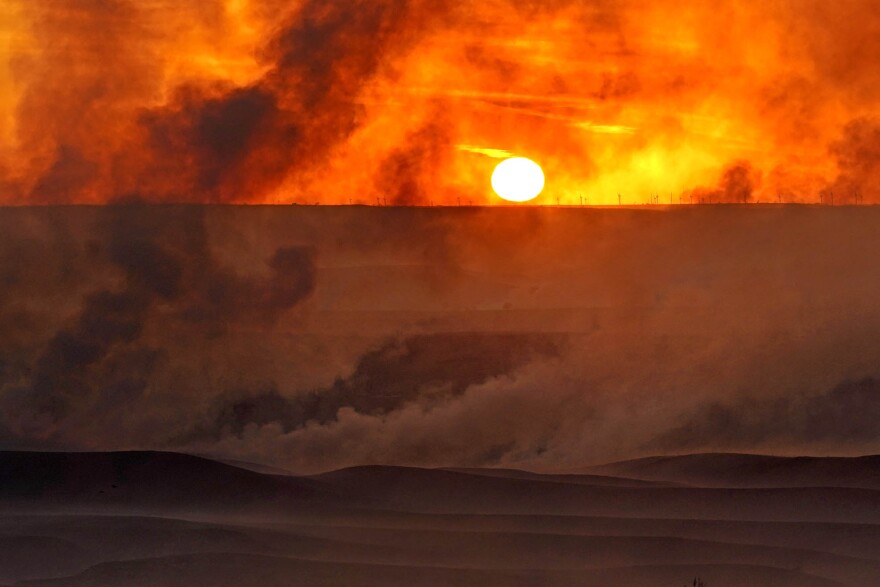Across vast stretches of the country, the first responders to a fire are all volunteers. But the number of calls for help has tripled in recent decades, even as the National Volunteer Fire Council reports that the ranks of volunteers look decidedly thinner.
Then came the pandemic.
When an enormous wildfire raced toward his hometown on the high plains of Paradise, Kansas, last December, volunteer fire chief Quentin Maupin put down his farm work and sprang to action. He took the department's 18,000-pound pumper truck out alone.
"Normally, our policy is you need two people on a truck, so if you have trouble, the other person can help out here or there," Maupin said. "But that day, there wasn't anybody here. And I knew we just gotta get a truck out there right now."
That initiative nearly cost Maupin his life when a wall of flames twice the height of telephone poles suddenly engulfed the truck, destroyed its brake lines and melted its flashing lights. Maupin escaped to check on his family in the path of the blaze and went back to work fighting the fire.
Maupin’s brush with disaster came on a day in mid-December when wildfires raged across much of western Kansas. All the departments in the area mobilized against the inferno, but there aren’t as many volunteers here as there used to be. said it was fire was too widespread with too few volunteers to tame it
“'It's rural Kansas and there just isn't that many people out here anymore,” he said. “And young people, that's the other thing. …”
Maupin said it's hard to make a living here, many work 40 or 50 miles from home. Around the country, volunteer fire departments have seen crews shrink as demand for service climbs.
The National Volunteer Fire Council's most recent count shows a 17% drop in the number of volunteer firefighters since 1984. But calls for service have more than tripled in that time, and calls for help have grown more complex.

"It used to be pretty simple. If you had a, a crime going on, you call the police. If there was a fire, you'd call the fire department. But fire department now does everything," said Eric Bernard director of Volunteer Fire and Rescue operations in Montgomery County, Maryland, where 1,500 volunteers work alongside some 1,200 career firefighters and paramedics. "We call it all hazards. So hazardous materials to electrical, water issues, a tree on a house."
He said there's a new hazard for firefighters, too, COVID-19. Bernard said Rockville deputy volunteer fire chief Scott Emmons helped evacuate injured police officers from the U.S. Capitol on Jan. 6 last year. A couple of weeks later, he tested positive for what ultimately turned out to be a fatal case of COVID-19.
"We lost a 30-year active chief officer who was 48 years old, that served at the Capitol. That was devastating,” Bernard said. “We had to put on a departmental funeral to say goodbye to a 48-year-old. That's what COVID did to us.”
The pandemic is hitting volunteer fire department budgets, too, and costing lives
And that's not uncommon. The National Volunteer Fire Council says COVID-19 has killed about 100 volunteer firefighters, including many who contracted the disease on emergency calls.
The pandemic has also hit volunteer fire department budgets, according to Fire chief Jennifer Williams in rural Chickasaw County, Mississippi.
"Typical volunteer fundraising activities you know, you sell plates or you have a luncheon. Well, you really can't do that with COVID,” Williams said. “People don't wanna gather."
The fundraising she's talking about isn't for extras. Some departments rely on events, selling food, and asking for donations at intersections to buy essential safety equipment. That includes things like, hydraulic extraction tools used to pry open wrecked vehicles to rescue victims. Williams said the closest department with a so-called "jaws of life" is a good 15 minutes away.
"And if you're trapped in a car, you don't have 15 to 20 minutes," Williams said. "But we don't have extrication tools. We can't afford extrication tools. A set is about $18,000. We don't have $18,000 to spend."
Williams is having trouble just replacing worn-out firehoses and protective clothing. That makes fighting fires even more dangerous, and it doesn't do much for recruitment or retention.
Many volunteer firefighters are past age 50 and the grueling work takes a toll.
And it's not just that fewer firefighters are responding to more calls. The age of those volunteers is trending older. The National Volunteer Fire Council says that in small-town volunteer fire departments, more than a third of firefighters are over the age of 50.
In western Kansas, farmer and rancher Keith Koelling serves as district fire chief for the Natoma Volunteer Fire Department. Koelling is 62 and says that the hellish wildfire in December pushed him to the brink.
"I went right at 40 hours straight. Went to sleep for about four hours. And then I was back up and went for another 15," he said. "Come to find I had COVID at the same time. I hit a brick wall. I mean, I just shut down. I'm too old for that."
Some volunteer fire departments have figured out how to do more with less. It's a formula that generally involves constant recruitment, and aggressive public relations. Others struggle to do more with less, a formula stretching the volunteers who do show up increasingly thin.
Copyright 2022 KCUR 89.3. To see more, visit KCUR 89.3. 9(MDA0NTM3OTcyMDEyNjIwNDkzMjFhNTlkZg004))


